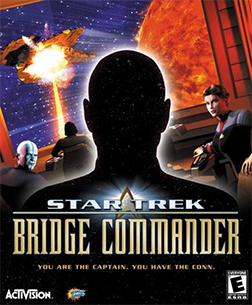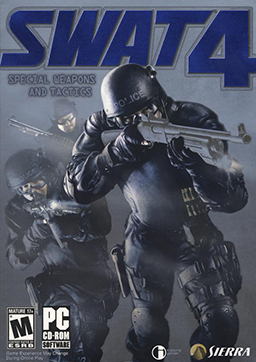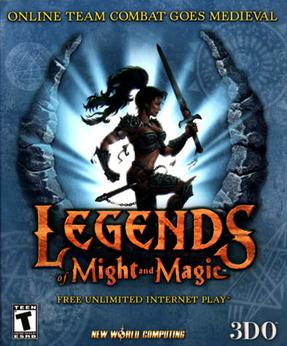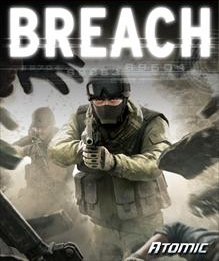
Soldier of Fortune is a first-person shooter video game developed by Raven Software and published by Activision in 2000 for Microsoft Windows. It was later released for the PlayStation 2, as well as the Dreamcast, while Loki Software also made a port for Linux. It was digitally re-released on GOG.com on October 2, 2018, along with its two successors. The player takes on the role of a U.S. mercenary as he trots around the globe hoping to halt a terrorist nuclear weapons plot.

Star Trek: Bridge Commander is a space combat simulation video game for Microsoft Windows, developed by Totally Games and published by Activision in 2002, based in the Star Trek universe.

Team Fortress Classic is a first-person shooter game developed by Valve and published by Sierra Studios. It was originally released in April 1999 for Windows, and is based on Team Fortress, a mod for the 1996 game Quake. The game puts two teams against each other in online multiplayer matches; each member plays as one of nine classes, each with different skills. The scenarios include capture the flag, territorial control, and escorting a "VIP" player.

Starsiege: Tribes is a first-person shooter video game. It is the first of the Tribes video game series and follows the story from Metaltech: Earthsiege and Starsiege. It was developed by Dynamix and published by Sierra On-Line in 1998. An expansion pack, Tribes Extreme, was cancelled; it was supposed to add single-player missions, multiplayer maps, and bot AI.

Battlefield 2 is a first-person shooter video game developed by Digital Illusions CE and published by Electronic Arts for Microsoft Windows. It was released in June 2005 as the third game in the Battlefield franchise.

Soldier of Fortune II: Double Helix is a first-person shooter video game developed by Raven Software, the sequel to Soldier of Fortune. It was developed using the id Tech 3 engine as opposed to the original's id Tech 2, and published in 2002. Once again, Raven hired John Mullins to act as a consultant on the game. Based on criticisms of the original game, Raven Software developed Soldier of Fortune II to be a more "realistic" game, with more modern tactical shooters like Operation Flashpoint: Cold War Crisis (2001) and Tom Clancy's Rainbow Six (1998) serving as inspirations, rather than Quake (1996).

SWAT 3: Close Quarters Battle is a 1999 tactical first-person shooter video game developed by Sierra Northwest and published by Sierra Entertainment exclusively for Microsoft Windows. It is the seventh installment of the Police Quest series and the third installment in the SWAT subseries. SWAT 3 follows the Los Angeles Police Department (LAPD) Metropolitan Division SWAT team as they combat a wave of violent crime and terrorism in Los Angeles in the lead-up to a nuclear disarmament treaty signing.
Soldat is a 2D multiplayer video game for Microsoft Windows. It is a run and gun game influenced by Liero and Scorched Earth, combined with elements from Counter-Strike and Worms.

Vietcong is a 2003 tactical first-person shooter video game developed by Pterodon in cooperation with Illusion Softworks and published by Gathering for Microsoft Windows. It is set during the Vietnam War in 1967.

SWAT 4 is a 2005 tactical first-person shooter video game developed by Irrational Games and published by Sierra Entertainment exclusively for Microsoft Windows. It is the ninth installment in the Police Quest series and the fourth installment in the SWAT subseries. In SWAT 4, the player commands a police SWAT team in the city of Fairview, New York. Unlike its predecessor, SWAT 3: Close Quarters Battle, SWAT 4 does not have an overarching plot. Instead, gameplay takes place over a series of unconnected deployments of the player's SWAT team, as they are sent to apprehend criminals, terrorists, gangs, and cults in and around Fairview.

Legends of Might and Magic is a first-person shooter video game developed by Jon Van Caneghem through New World Computing and published by The 3DO Company in 2001. As a spin-off of the Might and Magic franchise, Legends has a fantasy theme. Reviews likened the game to a medieval Counter-Strike, but criticized it for being a mediocre clone.

Starship Troopers is a first-person shooter game developed by British company Strangelite Studios and published by Empire Interactive. The game is based on the 1997 movie of the same name by Paul Verhoeven.

Battlefield: Bad Company 2 is a first-person shooter video game developed by DICE and published by Electronic Arts for Microsoft Windows, PlayStation 3, Xbox 360, iOS, Android and Kindle Fire systems. It is a direct sequel to Battlefield: Bad Company and is part of the Battlefield game series. It was released worldwide in March 2010. The iOS port was released on the App Store on December 16, 2010. The Android and Kindle Fire versions were released in June 2012.

Breach is a team-based first-person shooter multiplayer video game developed by Atomic Games. It was announced on March 26, 2010 at PAX East 2010 for Windows PCs and the Xbox 360. Breach was distributed online for the Xbox 360 by Xbox Live Arcade, and on Windows by Steam. It features dynamic destructible environments and a cover system.
Tribes: Ascend is a free-to-play first-person shooter developed and published by Hi-Rez Studios for Microsoft Windows, as part of the Tribes series. Aspects from previous Tribes games such as jetpacks and skiing are featured in the game.

Chivalry: Medieval Warfare is a multiplayer-focused hack and slash developed by Torn Banner Studios as their first commercial title. The game is set in a fictional setting. On September 20, 2012, a trailer was released which set the release date to October 16, 2012. The developers had confirmed that the game would be PC exclusive initially, but in October 2014, they confirmed that the game would be coming to PlayStation 3 and Xbox 360 in December 2014. A standalone expansion pack called Chivalry: Deadliest Warrior was announced on August 23, 2013, as a tie-in for the television series Deadliest Warrior. It was released on November 14, 2013.

Cobalt is an action side-scrolling video game developed by Oxeye Game Studio and published by Mojang Studios. It was released on 2 February 2016 for Microsoft Windows, Xbox 360 and the Xbox One consoles.

Battlefield 1 is a first-person shooter game developed by DICE and published by Electronic Arts. It is the tenth installment in the Battlefield series and the first main entry in the series since Battlefield 4 in 2013. It was released for PlayStation 4, Windows, and Xbox One in October 2016.

Insurgency: Sandstorm is a multiplayer tactical first-person shooter video game developed by New World Interactive and published by Focus Home Interactive. The game is a sequel to the 2014 video game Insurgency. Set in an unnamed fictional Middle Eastern region, the game depicts a conflict between two factions: "Security", loosely based on various militaries ; and "Insurgents", loosely based on various paramilitary and terrorist groups.

Valorant is a free-to-play first-person tactical hero shooter developed and published by Riot Games, for Windows. Teased under the codename Project A in October 2019, the game began a closed beta period with limited access on April 7, 2020, followed by a release on June 2, 2020. The development of the game started in 2014. Valorant takes inspiration from the Counter-Strike series, borrowing several mechanics such as the buy menu, spray patterns, and inaccuracy while moving.


















